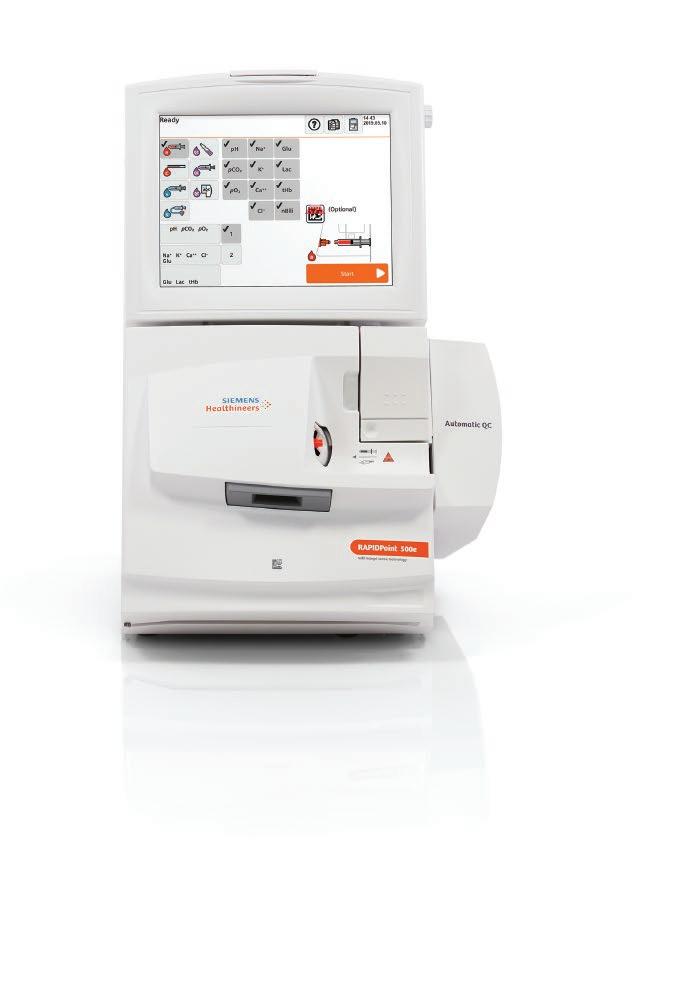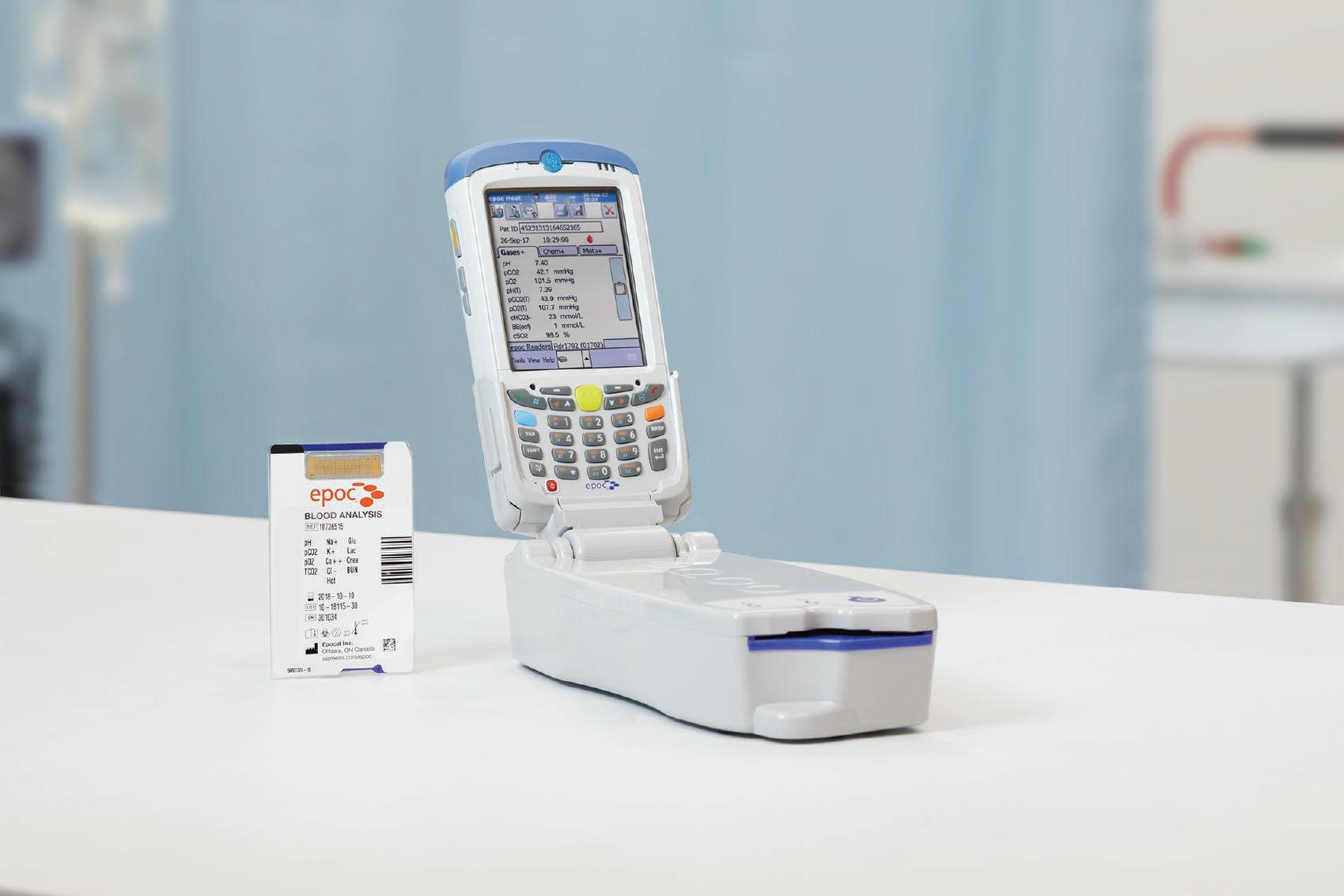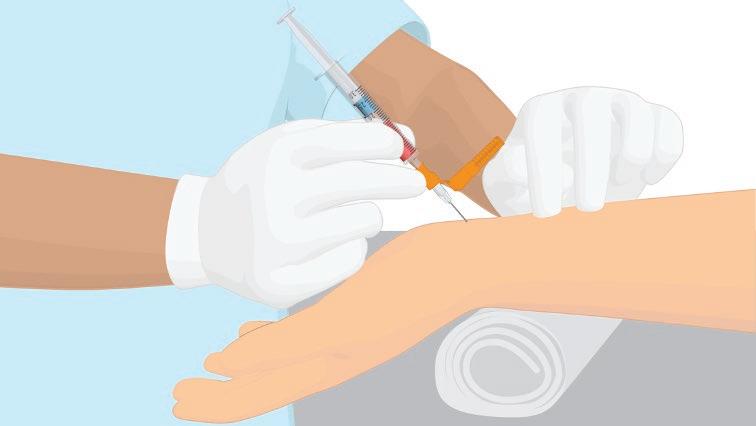
7 minute read
Blood Gas Analysis: Applications for Decentralized Testing
from Improving the Diagnosis and Monitoring of Critically ill Patients and the Role of Blood Gas Testing
Sophie Laurenson, BSc. BSc. (Hons.), PhD. (Cantab), EMBA, MRSNZ
Blood gas analysis measures the levels of pH, oxygen, carbon dioxide, and bicarbonate in circulation. These assays are used to evaluate abnormalities in the degree of pulmonary gas exchange and metabolism and are used in the evaluation of numerous clinical indications.
Introduction
The interplay between the cardiovascular and respiratory systems is critical in maintaining homeostasis. The levels of gases, electrolytes, and metabolites in circulation influence the equilibrium between oxygen delivery and tissue demand, as well as the acid-base balance of the human body. Deviations in this equilibrium manifest in numerous diseases affecting the respiratory, cardiovascular, and metabolic systems. Blood gas analysis enables healthcare professionals to evaluate patients across a range of clinical settings, allowing improved clinical decision-making.
The Physiology and Pathology of Gas Exchange
The lungs play a critical role in gas exchange by mediating the exchange of gases between air and blood through passive diffusion 16 . However, the lungs constitute only one component of a broader system, including the cardiovascular system (the heart, vasculature, and blood) and metabolic organs. The processes of ventilation and perfusion rely on harmony between each of the components of the cardiorespiratory system. Many cardiopulmonary diseases are caused by disturbances in either ventilation or perfusion of the lung alveoli and are evaluated using blood gas analysis 17 .
Fundamentals of Blood Gas Analysis
Blood gas analysis evaluates abnormalities in the degree of pulmonary gas exchange and metabolism, including the adequacy of ventilation, oxygenation, and acid-base status 18 . The values of carbon dioxide and oxygen are expressed as the partial pressure of carbon dioxide (PaCO 2 ) and the partial pressure of oxygen (PaO 2 ). They are essential factors in the diagnosis and treatment of patients with pulmonary and other critical conditions. The pH and bicarbonate concentration assist in the diagnosis of renal and metabolic diseases. Many modern blood gas analyzers also test for electrolytes (Na + , K + , Cl - , Ca ++ ) and metabolites such as glucose and lactate. Co-oximetry tests measure concentrations of hemoglobin species including oxygenated hemoglobin (oxyHb), deoxygenated hemoglobin (deoxyHb), carboxyhemoglobin (COHb), and methemoglobin (MetHb) to determine blood oxygen saturation.
Blood gas analysis is used routinely in patient care throughout different levels of the health system. It is pivotal in initial evaluations of patients presenting with dyspnea or respiratory distress. Within lower levels of care, oxygenation status is often assessed using non-invasive techniques such as pulse oximetry or subcutaneous measurement of carbon dioxide 19 . Patients that progress to severe pulmonary diseases such as acute respiratory distress syndrome (ARDS), and respiratory failure require routine blood gas testing and monitoring 20 . Blood gas analysis is also used to diagnose other critical conditions such as sepsis and septic shock 21 , heart failure and cardiac arrest, and hypovolemic shock. Metabolic disorders such as diabetic ketoacidosis, renal tubular acidosis, and inborn errors of metabolism also cause abnormalities in blood gas values 17 .
Interpreting blood gas analysis results can be challenging, as the factors affecting blood gas values are often multifactorial and complex 22 . There are five leading causes of hypoxemia, including ventilation/perfusion (VQ) mismatch, hypoventilation, reduced F i O 2 , shunting, impaired diffusion of oxygen across the alveolar membrane 23 . Each of these mechanisms may contribute to deviations in oxygen and carbon
POC epoc Blood Analysis System offers patient-side testing of critical analytes
dioxide tensions. Blood gas values may be further affected by compensatory mechanisms intended to balance gas exchange instabilities through increasing ventilation, improving oxygen extraction, or increasing cardiac output.
In addition to diagnosis, blood gases, electrolytes, and metabolites are commonly used to evaluate disease severity, intervention efficacy, and prognosis. Systematic interpretation of blood gas values assists in understanding whether the primary disorder is respiratory or metabolic in origin, acute or chronic in nature, and the severity of abnormalities 24 . There are various modalities available to assess and treat patients presenting with cardiorespiratory diseases. Selecting the optimum management strategy relies on the accurate, rapid measurement of analytes to titrate treatments to the required physiological target.
Blood Gas Analyzers: Integrated Analysis of Critical Analytes
The first commercially-available blood gas analyzers were introduced into clinical laboratories in the 1960s 25 . They have become the mainstay of intensive care patient management in hospital settings. Subsequent technological advances in electronics, sensors, and informatics have enabled the miniaturization of blood gas instruments and consumables, facilitating their use in decentralized care settings.
The first combined blood gas and electrolyte analyzer was launched in the 1980s, enabling measurements of pCO 2 , pO 2 , as well as the electrolytes sodium (Na + ), potassium (K + ), and calcium (iCa), and hematocrit 26 . The introduction of blood gas analyzers capable of measuring these analytes in whole blood further expanded their utility in critical care analyzers. Modern analyzers are capable of executing a broad menu including pH, pCO 2 , pO 2 , Na + , K + , Cl - , iCa, iMg,
RAPIDPoint 500e Blood Gas System provides results in 60 seconds

hematocrit, glucose, lactate, creatinine, urea, hemoglobin, O 2 saturation, and co-oximetry. Expanded test menus enable critical care blood gas analyzers to provide actionable findings across many clinical indications.
Demand for Blood Gas Testing
Blood gas analysis is used to evaluate numerous diseases of cardiopulmonary and metabolic origin. Consequently, it is one of the most frequently ordered tests in healthcare organizations. Severe pulmonary disease has a substantial impact on global public health. The estimated incidence is 34 and 5-7 cases per 100,000 patients per year in the U.S.A. and European countries, respectively 27, 28 . In lowincome countries, under-reporting is common, although it has been observed that 4% of all hospital admissions present with clinical signs and symptoms similar to those of ARDS 29 . In the U.S.A., ARDS patients represent 7% of ICU patients and 16% of those requiring mechanical ventilation 18 . Historical estimates of severe pulmonary diseases such as ALI and ARDS
POC epoc Blood Analysis System offers a broad menu on a single test card

indicated that cases in Europe were significantly lower than those reported in the USA. However, the recent COVID-19 pandemic is likely to alter historical estimates of incidence and prevalence, as many health systems have experienced increased utilization of ICU facilities.
Intensive care medicine requires significant resources, and costs are projected to rise with the introduction of new therapeutic and diagnostic modalities. Up to 25% of ICU expenditure is consumed by laboratory testing, a trend which is also increasing 30-32 . Arterial blood gas analysis (ABG) is the most frequently ordered laboratory test in ICU facilities 33 . A study of testing utilization at the Brigham and Women’s Hospital in Boston, MA, showed almost 100,000 ABG tests ordered per year 34 . Improving the efficiency of clinical workflows helps to contain costs while enhancing patient care experiences and outcomes.
Blood Gas Analysis at the Point-Of-Care (PoC): Improving Clinical Workflows and Efficiency
PoC testing is frequently used in critical care settings to deliver decentralized care to patients in emergency departments (EDs), Intensive Care Units (ICUs), and ambulances 35 . Rapid assessment of blood gas and electrolytes may improve clinical outcomes in critically ill patients through efficient clinical decision making and reduced therapeutic turnaround time (TTAT). This is enabled by making data rapidly available at the point-of-use. PoC tests are commonly simplified systems with self-contained components and user-friendly interfaces. These features allow them to be used by healthcare professionals outside of the clinical laboratory environment. Rapid sample processing and simplified instruments also reduces sampling and preanalytic testing errors, affecting blood gas analysis. Finally, PoC instruments require small sample volumes, facilitating serial testing for patient monitoring while minimizing patient discomfort or adverse side-effects. In combination, the convenient, user-friendly nature of PoC blood gas analyzers has expanded testing capacity for many healthcare organizations.
Conclusion
Blood gas analysis is one of the most important services in the care of critically ill patients. The levels of pH, oxygen, carbon dioxide, and bicarbonate in circulation are used to evaluate abnormalities in the degree of pulmonary gas exchange and metabolism in numerous clinical indications. To meet the increasing global demand for blood gas testing services, point-of-care analyzers enable decentralized testing in emergency departments, intensive care units and remote settings.







